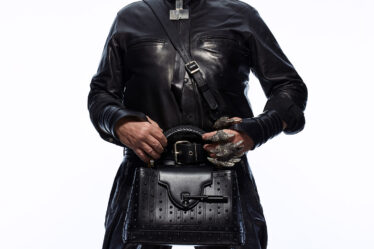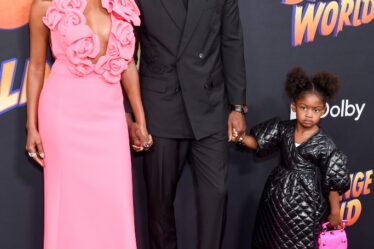
On Friday, Porsche held an exclusive party on a West Hollywood rooftop to celebrate the launch of not a new car, but a suitcase.
The €2,250 ($2,453) case was designed in partnership with German premium luggage brand Rimowa — featuring the company’s signature grooved aluminium design — to pay homage to the storied Porsche 911 sports car, multiple of which filled the venue Friday night, exhibiting the luggage inside their trunks. Attracting a young crowd, the launch also featured five spy thriller-style short films screened at the party that highlighted the collaborative efforts of the two brands.
The Porsche-Rimowa suitcase joins a long list of recent streetwear-influenced collaborations between carmakers and fashion labels, including a new Maybach car designed by the late Virgil Abloh unveiled last week, a Maserati clothing range created with Japanese designer Hiroshi Fujiwara, and a partnership between skateboarding label Palace and Mercedes-AMG. The latter tie-up includes a full clothing range and four special edition cars. Mercedes, an increasingly frequent fashion collaborator, also partnered with streetwear labels Heron Preston and Off-White last year.
The motorsports industry as a whole is looking to align itself with fashion. Racing competition Formula 1 has used streetwear collaborations with brands like Bape to shake off the sport’s stuffy and elitist reputation, marketing itself to a young and fashion-savvy Gen-Z audience.
By teaming up, fashion groups and carmakers not only reach new, affluent consumers but also place novel product categories in front of their most avid fans. It’s not just about selling more cars or creating a new revenue stream. Fashion companies benefit from the association of prestige automakers. Similar to how skateboarding and hip-hop have influenced the menswear market, the culture around performance cars is also creating aspirational markers in fashion.
All the while, companies like Maybach-owner Mercedes-Benz and Jaguar covet visibility among young, stylish consumers who may not ever purchase a $200,000 vehicle but might one day purchase a car branded hoodie if the brand has successfully been marketed as cool.
Similarly, The new Porsche-Rimowa suitcase will reach younger customers who may not own a Porsche, said Deniz Keskin, the company’s head of brand management and partnerships, “but it gives them a chance to enter the brand’s world.”
A More Refined Approach
Tie-ups between carmakers and fashion brands are nothing new. British menswear label Hackett has worked with Aston Martin for almost 20 years. The relationship began when Aston Martin requested to have their Formula 1 drivers’ clothing sponsored by the brand, but it has evolved into a more collaborative partnership in recent years. Today, the companies’ respective design teams work side-by-side on Hackett’s Aston Martin-branded polos and puffer vests, according to Mark Blenkinsop, chief marketing officer of AWWG, Hackett’s parent company.
This deeper level of collaboration is indicative of a wider trend, where licensing deals and logo swaps aren’t enough to pique the interest — and wallets — of consumers. Today, the working relationship between auto companies and fashion brands is far more elaborate, highlighting an alignment between their respective products and target audiences. Rimowa and Porsche hone in on their mutual status as German premium design brands, while Maserati’s collaboration with Zegna in 2020 was rooted in their “mutual passion for ‘Made in Italy,’” the brands said at the time.
Nowadays, such collaborations are reaching more discerning consumers, according to Walter D’Aprile, founder of Nss Factory, a Milan-based creative agency. For instance, Gucci’s 2011 collaboration with Fiat simply featured its classic green and red stripes on a special edition Fiat 500 car — a tie-up that wouldn’t fly today, D’Aprile said.
We only collaborate where there is a genuine story to tell or an experience we can create that makes sense for us.
Today, a collaboration requires creating a narrative that explains why it makes sense in the first place. The Palace-Mercedes collaboration was popular with consumers because the colourful, stylish workwear and matching one-of-a-kind art cars designed for the launch reflected Palace’s reputation for daring collaborations that take fashion into new arenas across sport and lifestyle.
“We refuse a lot of brand collabs related to cars,” said Arthur Kar, owner of the L’Art De L’Automobile luxury car dealership that works at the growing intersection of fashion and high-end automobiles and has collaborated with the likes of Porsche and Dover Street Market.
“It’s not because we don’t respect the brands approaching us,” Kar said. “But we only collaborate where there is a genuine story to tell or an experience we can create that makes sense for us.”
Formula 1′s Fashion Icons
Following the footsteps of the NBA and the Premier League, racing competition Formula 1 is becoming a fashion marketing arena in its own right as some of its athletes have become style icons, including Lewis Hamilton and Guanyu Zhou, the first Chinese driver to race in the competition.
Zhou is often pictured pre-race in full Prada looks and is an ambassador for luxury watchmaker Hublot, while Hamilton arrives wearing eye-catching looks from Bottega Veneta, Jacquemus and Ahluwalia, sharing content with his 27.5 million Instagram followers. For brands, each race day creates valuable product placement opportunities. The sport’s rising popularity among young people in North America has led to partnerships like the Tommy Hilfiger-Lewis Hamilton fashion line, which launched in 2018.
Ferrari, which runs its own Formula 1 team, debuted at Milan Fashion Week in February, presenting its second ready-to-wear collection as part of its efforts in building a fully-fledged fashion line.
The pieces, including a $1,750 recycled nylon jacket in its trademark red and black and a $2,000 leather backpack, incorporate modified fabrics used in Ferrari cars and reference the uniforms of racing drivers and crew members. But they’re not expected to be a significant revenue driver for the company. Instead, the fashion line will help elevate Ferrari’s other licensed products like wallets and gloves.
“Fashion is a great way to reach a bigger audience and make the brand relevant to people’s lifestyle,” Ferrari’s chief brand diversification officer told BoF in June.



